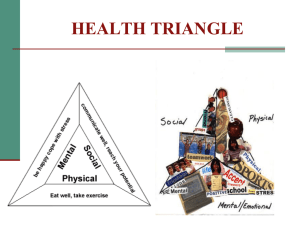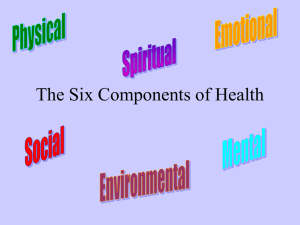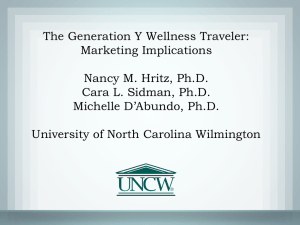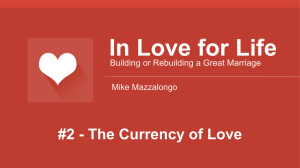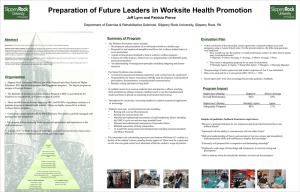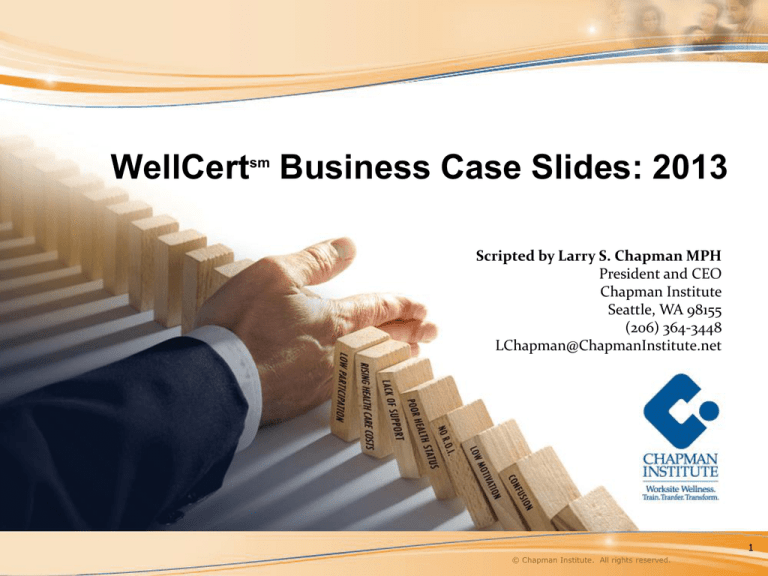
WellCertsm Business Case Slides: 2013
Scripted by Larry S. Chapman MPH
President and CEO
Chapman Institute
Seattle, WA 98155
(206) 364-3448
LChapman@ChapmanInstitute.net
1
© Chapman Institute. All rights reserved.
Purpose of this Slide Deck….
“The purpose of this slide deck is
to provide WellCertsm graduates
with a set of slides to make the
best possible case for worksite
wellness funding and
programming. I have scripted
each slide in the ‘Notes Page
view’ with what I would say if I
were presenting that slide to
senior managers. Good luck with
your own wellness advocacy
efforts!”
-LSC
2
© Chapman Institute. All rights reserved.
Many Perspectives on Wellness
• Physical
– Fitness, nutrition, medical self-care,
control of substance abuse
• Emotional
– Care for emotional crisis,
stress management
• Social
Emotional
– Communities, families, friends
• Intellectual
– Educational, achievement,
career development
Physical
• Spiritual
– Love, hope, charity
NWI
Social
Intellectual
Spiritual
AJHP
Source: American Journal of Health Promotion (AJHP) & National Wellness Institute (NWI)
3
© Chapman Institute. All rights reserved.
p. 2
Key Definitions
Wellness — “An intentional choice of a lifestyle characterized by
personal responsibility, moderation,
and maximum personal enhancement of physical,
mental, emotional and spiritual health.”
Worksite Wellness Program — “An organized program in the worksite
that is intended to assist employees and their family members
(and/or retirees) in making voluntary behavior changes which
reduce their health and injury risks, improve their health
consumer skills and enhance their individual productivity and wellbeing.”
4
© Chapman Institute. All rights reserved.
Most of Us are Connected to a Worksite
82% of U.S. population has employer connection
Source: The National Data Book, 2012.
5
© Chapman Institute. All rights reserved.
Top Ten Causes of Death: U.S. 1900 and 2010
1900
1. Pneumonia (all forms) and influenza
2. Tuberculosis (all forms)
3. Diarrhea, enteritis, and ulceration of
the intestines
4. Diseases of the heart
5. Intracranial lesions of vascular origin
6. Nephritis (all forms)
7. All accidents
8. Cancer and other malignant tumors
9. Senility
10. Diphtheria
2010
1. Heart disease
2. Cancer
3. Respiratory disease
4. Stroke
5. All accidents
6. Alzheimer’s disease
7. Diabetes
8. Nephritis
9. Pneumonia (all forms) and influenza
10. Suicide
Source: CDC, 2013.
6
© Chapman Institute. All rights reserved.
Top Ten Causes of Death By Age Group: U.S. 2010
7
© Chapman Institute. All rights reserved.
Obesity Trends* Among U.S. Adults BRFSS, 1990, 2000, 2010
2000
1990
2010
(*BMI 30, or about 30 lbs. overweight for 5’4” person)
No Data
<10%
10%–14%
15%–19%
20%–24%
25%–29%
≥30%
8
© Chapman Institute. All rights reserved.
Health Benefit Cost Trends Affect Wellness
© Chapman Institute. All rights reserved.
Future Direction of Healthcare Cost Growth?
Restraining Cost
Major
•
•
•
•
•
Aging
Technology
Risk factors increasing
Cost shifting increasing
Market imperfections
Minor
Enhancing Cost
•
•
•
•
•
•
•
•
•
Managed care limits
Defensive medicine
Collective bargaining pressures
Entitlement mentality
Margin/profitability erosion
Complexity of human health
Quality artifacts
Costs of privacy/confidentiality
Confusion about health & healthcare
• Employee cost sharing
• DC approach
• Selected technological
developments
• Improved price competition
• Prevention improvements
• Enlarged public role
• EDI applications
• Selected alternative therapies
10
© Chapman Institute. All rights reserved.
Health Spending is Not Normally Distributed
$150/person
Generally well with episodic
need for services
A Small
Percentage of
Employees
Account
for a Large
Percentage of
Claims Cost
Chronically ill requiring
systematic management:
e.g. diabetes, hypertension
$20,000/person
Complex, multiple problems
requiring aggressive, unique
case management: e.g.
Alzheimer's
% of Employees
% of Claims
© Chapman Institute. All rights reserved.
Factors that Determine the Amount of Healthcare You Use
Demand-Side Factors
Age*
Supply-Side
Factors (outside
the individual)
Extent and
scope of
insurance
coverage*
(inside the individual)
Sense of
responsibility
for personal
health*
Clinical risk
factors*
Point-of-use
cost sharing*
Current
morbidity*
Geographic
access to
services
Self-efficacy*
* =Potentially modifiable.
Gender
Personal
health
behavior*
Attitudes
about
personal
health and
health
care
use*
Supply-Side
Factors (outside
the individual)
Regional or
local practice
patterns
Provider
incentives
affecting
diagnosis and
treatment
decisions*
Source: L. Chapman, 2010
12
© Chapman Institute. All rights reserved.
Important Quote….
…….almost two thirds of the
growth in national health spending
over the past 20 years can be
attributed to Americans’
worsening lifestyle habits and, in
particular, the epidemic rise in
obesity rates.”
Source: Goetzel, R.Z., Pickens, G.T., Kowlessar, N.M., The Workforce Wellness Index: A
Method for Valuing U.S. Workers’ Health, J Occup Environ Med, Feb 2013, 55(2):1-8.
13
© Chapman Institute. All rights reserved.
Health Risks Increase Health Costs (Original HERO Study)
N = 46,000+ X 3 yrs
Percent Higher Annual Health Plan Costs
Source: Goetzel RZ, et. al. (1998, October). The relationship between modifiable health risks and health care expenditures: An analysis of the
multi-employer HERO health risk and cost database. JOEM, 40(10):843-54.
© Chapman Institute. All rights reserved.
Health Risk Factor Definitions
Risk Factors
Body mass index
Blood pressure
Cholesterol
Blood glucose
Tobacco
Alcohol
Stress
Exercise
High-Risk Definitions
BMI ≥30
Systolic ≥140 mmHg or diastolic ≥90 mmHg
Total cholesterol ≥240 mg/dL
Total blood glucose ≥126 mg/dL
Currently smokes cigarettes or uses tobacco
More than two drinks per day
Often feels stressed and has trouble coping
Fewer than 2 days per week of at least 20
minutes of exercise or self-reported
non-exerciser/light exerciser in the previous
month
Source: Goetzel, R.Z., Pickens, G.T., Kowlessar, N.M., The Workforce Wellness Index: A Method for Valuing U.S. Workers’ Health, J Occup Environ
Med, Feb 2013, 55(2):1-8.
15
© Chapman Institute. All rights reserved.
Percent Higher Cost of Key Health Risk Factors (Updated HERO)
16
© Chapman Institute. All rights reserved.
Prevalence of Key Health Risk Factors (Frequency)
17
© Chapman Institute. All rights reserved.
Annual Medical Plan Cost
Association Between Changes in Health Risk Status and
Changes in Future Health Care Costs
$250
$200
$150
$100
$50
$0
-$50
-$100
-$150
$210
Add a Health Risk Factor
N = 22,723
Reduce a Health Risk Factor
-$129
Source: Steven Nyce, Jessica Grossmeier, David Anderson, Paul Terry and Bruce Kelley, Association Between Changes in Health Risk Status
and Changes in Future Health Care Costs: A Multiemployer Study, JOEM, November, 2012, 54(11): 1364 – 1373.
18
© Chapman Institute. All rights reserved.
Relationship of Risk Factors to Medical Conditions
Source: Bolnick, H., Millard, F., and Dugas, J., Medical Care Savings from Workplace Wellness Programs, JOEM
2012, Jan, 55(1): 4-9.
19
© Chapman Institute. All rights reserved.
Percent of Total Medical Care Expenses Due to Risk Factors
Age Groups
Source: Bolnick, H., Millard, F., and Dugas, J., Medical Care Savings from Workplace Wellness Programs, JOEM 2012, Jan, 55(1): 4-9. Uses WHO Global Burden of Disease
and Risk Factors Study and The Medical Expenditure Panel Surveys of the NCHS.
20
© Chapman Institute. All rights reserved.
Percent of Total Medical Care Expenses Potentially Preventable
Age Groups
Source: Bolnick, H., Millard, F., and Dugas, J., Medical Care Savings from Workplace Wellness Programs, JOEM 2012, Jan, 55(1): 4-9. Uses WHO Global Burden of Disease
and Risk Factors Study and The Medical Expenditure Panel Surveys of the NCHS. If theoretical minimums are reached.
21
© Chapman Institute. All rights reserved.
Lifetime Health Costs
$400,000
$361,192
$316,579
$350,000
$268,679
$300,000
Vision/Hearing
Dental
Rx
Professional
Nursing Home
Hospital
$250,000
$200,000
$150,000
$100,000
$50,000
$0
Total
Female
Male
N = 3.7 million
Source: Alemayehu, B., Warner, K.E., The Lifetime Distribution of Health Care Costs, Health Services Research, (June, 2004), 39:3, p. 627 – 642.
22
© Chapman Institute. All rights reserved.
Average Annual Health Cost Growth
10%
9%
8%
The average amount of increase in
health care costs with one more year
of age.
7%
6%
4.1%
5%
4%
3%
2%
1%
0%
One Year of Age
Source: Alemayehu, B., Warner, K.E., The Lifetime Distribution of Health Care Costs, Health Services Research, (June, 2004), 39:3, p. 627 – 642.
23
© Chapman Institute. All rights reserved.
Healthcare Spending Doesn’t Stay High Over Time
Dollars per Qtr
N = 29,472
Quarters
Source: Musich, S., Schultz,A., Burton, W., Edington, D., Overview of Disease Management Approaches: Implications for Corporate-Sponsored Programs.
Disease Management & Health Outcomes. 2004, 12(5):299-326.
© Chapman Institute. All rights reserved.
Financial Impact of Selected Health Risk Factors
Cost Per Year
N = 63,013
Source: Kowlessar NM, Goetzel RZ, Carls GS, Tabrizi MJ, Guindon A., The relationship between 11 health risks and medical and productivity costs for a large employer. J
Occup Environ Med. 2011 May;53(5):468-77. N = 63,013.
25
© Chapman Institute. All rights reserved.
Cost Per Year
Financial Impact of Selected Health Risk Factors
N = 63,013
Source: Kowlessar NM, Goetzel RZ, Carls GS, Tabrizi MJ, Guindon A., The relationship between 11 health risks and medical and productivity costs for a large employer. J
Occup Environ Med. 2011 May;53(5):468-77. N = 63,013.
26
© Chapman Institute. All rights reserved.
Health Risks Increase Sick Leave Use (Early Study)
N = 35,451 X 1 yr
Percent Higher Absenteeism
Source: Serxner, S., et al., (2001). The impact of behavioral health risks on worker absenteeism. JOEM, 43(4), 347-354
© Chapman Institute. All rights reserved.
Health Risks Increase Workers’ Comp Cost (Early Study)
N = 3,388 X 4 yrs
Percent Higher Annual WC Costs
Source: Musich, S., et. al., (2001, June). The Association of Health Risks with Workers’ Compensation Costs, JOEM,, p. 534-541.
© Chapman Institute. All rights reserved.
Multiple Health Risks Multiply Cost (Early Study)
Multiples
N = 1,838
Multiples of annual
healthcare costs
compared to
someone with no
health risks
Number of Risks
Source: Yen, Louis, et al., (2004, Sept/Oct). Associations between health risk appraisal scores and employee medical claims costs in a manufacturing co., AJHP, 11(1), p. 46-54.
© Chapman Institute. All rights reserved.
Multiple Health Risks Multiply WC Cost (Early Study)
N = 3,338
(0 – 1)
(2 – 3)
(4+)
Health Risk Factors
Source: Musich, S., et. al., (2001, June). The Association of Health Risks with Workers’ Compensation Costs, JOEM, p. 534-541.
© Chapman Institute. All rights reserved.
Health Costs are Potentially Preventable (Early Study)
Preventable
25%
75%
• Depression
• Stress
• Blood Sugar
• Smoking
• Obesity
• Blood Pressure
• Sedentary Life
Not Related
N = 46,026 X 6 Yrs
Source: Anderson, et. al., (2000, Sept/Oct). The Relationship Between Modifiable Health Risks and Group-Level Health Care Expenditures, AJHP, 15(1), p. 45-52.
© Chapman Institute. All rights reserved.
Lifetime Health Costs Perspective
“Compression of Morbidity”
$ Annual Health Costs
Without Wellness
With Wellness
65
Birth
Death
Source: WellCert Program
32
© Chapman Institute. All rights reserved.
Presenteeism is a Major Cost for Employers
Enterprise-wide Health Costs
Percent of total labor costs
12.0%
10.0%
8.0%
Health Plan
10.7%
2.4%
1.5%
Other Health
Costs
Presenteeism
6.0%
4.0%
6.8%
2.0%
0.0%
Dow Chemical
N = 56,000+
Source: Collins, J., Baase, C., Sharda, C., Ozminkowski, R., Billoti, G., Turpin, R., Olson, M., and Berger, M., The assessment of chronic health conditions on work performance, absence
and total economic impact for employers, J Occup Environ Med., 2005, Jun: 47(6): 547-557.
33
© Chapman Institute. All rights reserved.
Economic Rationale for Worksite Wellness
Total = $28,541*
* = 2010 Dollars
Source: Goetzel, JOEM, (2004) data adjusted to 2010 by Mercer Employer Survey
Results and by Collins Presenteeism study (2005) of Dow Chemical that was used for
determining the Presenteeism cost.
34
© Chapman Institute. All rights reserved.
National Worksite Wellness Survey Results
Type of Programs Offered
Exercise/Physical Fitness
Smoking Control
Stress Management
Back Care
Nutrition
High Blood Pressure
Weight Management
Off-the-job Accidents
Job Hazards/Injury Prevention
Substance Abuse
HIV/AIDS Education
Cholesterol
Mental Health
Cancer Detection/Prevention
Medical Self-Care/CHE
STDs (Sexually Transmted Dis)
Prenatal Education
Employer Participants
1985
Survey
27%
36%
27%
29%
17%
16%
15%
20%
na
na
na
na
na
na
na
na
na
N=1358
1992
Survey
41%
40%
37%
32%
31%
29%
24%
18%
64%
36%
28%
27%
25%
23%
18%
10%
9%
N=1507
1999
Survey
36%
34%
35%
53%
23%
7%
15%
na
na
28%
25%
23%
12%
4%
14%
25%
12%
N=1544
2004
Survey
20%
19%
25%
45%
23%
36%
21%
na
na
na
15%
20%
na
22%
22%
na
19%
N = 730
Sources: Office of Disease Prevention and Health Promotion, U.S.P.H.S. National Survey of Worksite Health Promotion Activities: A Summary. Summer 1987,
p. 51., Office of Disease Prevention and Health Promotion, U.S.P.H.S. National Survey of Worksite Health Promotion Activities: A Summary. Spring 1993, p.
30., Association for Worksite Health Promotion, US Department of Health and Human Services, Office of Disease Prevention and Health Promotion, 1999 National
Worksite Health Promotion Survey: Report of Findings. Linnan, L., et.al., Results of the 2004 National Worksite Health Promotion Survey, Am J Public Health.
2008;98:1503–1509.
35
© Chapman Institute. All rights reserved.
Six Step to Designing Your Wellness Program
Step #1
Scope the Program
Step #2
Plan Infrastructure
Step #3
Plan Communications
Step #4
Plan Health
Management Process
Step #5
Plan Group Activities
Step #6
Plan Supportive
Environment
“Program” Infrastructure
“Administrative” Infrastructure
Source: Chapman, L., Planning
Wellness: Getting Off to a Good
Start, 2013, p. 227.
36
© Chapman Institute. All rights reserved.
There Are Several Ways to Do “Wellness”
Program Model
Main Features
Primary Focus
Traditional
Approach
Population
Health
Management
• Fun activity focus
• No risk reduction
• Mostly health focus
• Some risk reduction
• Add productivity
• Strong risk reduction
• No high risk focus
• Not HCM oriented
• All voluntary
• Site-based only
• No personalization
• Minimal Incentives
• Little high risk focus
• Limited HCM oriented
• All voluntary
• Site-based only
• Weak personalization
• Modest Incentives
• Strong high risk focus
• Strong HCM oriented
• Some required activity
• Site and virtual both
• Strongly personal
• Major Incentives
• No spouses served
• No evaluation
• Few spouses served
• Weak evaluation
• Many spouses served
• Rigorous evaluation
Quality of Work
Life
Morale-Oriented
Activity-Oriented
Results-Oriented
Source: Chapman, L., Planning Wellness: Getting Off to a Good Start, 2013, p. 227.
37
© Chapman Institute. All rights reserved.
The Overall Relationship of Risks to Health Costs
Source: 2012 Health Care Survey, Aon Hewitt, 2012, p. 62. www.aonhewitt.com
38
© Chapman Institute. All rights reserved.
Aon Hewitt 2012 Health Care Survey: PHM Intentions
Source: 2012 Health Care Survey, AonHewitt, 2012, p. 62. www.aonhewitt.com
N = 1,800+ employers
39
© Chapman Institute. All rights reserved.
Aon Hewitt 2012 Health Care Survey: PHM Interventions
Source: 2012 Health Care Survey, AonHewitt, 2012, p. 62. www.aonhewitt.com
N = 1,800+ employers
40
© Chapman Institute. All rights reserved.
Aon Hewitt 2012 Health Care Survey: PHM Intentions
Source: 2012 Health Care Survey, AonHewitt, 2012, p. 62. www.aonhewitt.com
N = 1,800+ employers
41
© Chapman Institute. All rights reserved.
Psychologically Healthy Companies have Lower
Turnover, Stress and Higher Satisfaction
Source: American Psychological Association, 2013.
42
© Chapman Institute. All rights reserved.
Summary of C/B Results
Bank of America
Blue Shield of CA
Duke University
Citibank
City of Birmingham
Coors
DuPont
General Foods
General Motors
GlaxoSmithKline
Indiana BCBS
Johnson & Johnson
Life Assurance
Nortel
Prudential
Travelers
Union Pacific
Washoe County
Traditional
Newer Programs
Outliers
C/B Ratio
•
•
•
•
•
•
•
•
•
•
•
•
•
•
•
•
•
•
Study Number
Source: Proof Positive: An Analysis of the Cost-Effectiveness of Worksite Wellness, Chapman Institute, Seventh Edition, 2013.
43
© Chapman Institute. All rights reserved.
2012 Meta-Evaluation Findings: Overview
Study Parameter
Average Study Years
Observational Years
Year Reported (Median)
# of Study Subjects
# of Control Subjects
Average # of Program Targets
% Change in Sick Leave
% Change in HCs
% Change in Workers’ Comp
% Change in Disability Mang.
C/B Ratio
Averages & Totals
(N=62)
3.83
241.3
1996
546,971
213,291
5.2
-25.1% (26)
-24.5% (32)
-40.4% (4)
-24.2% (3)
1:5.56 (25)
Source: Chapman, L. Meta-Evaluation of Economic Return Studies of Worksite Health Promotion Programs:2012 Update, America Journal of Health Promotion, March/April, 2012, 26(4): 1-12.
44
© Chapman Institute. All rights reserved.
C/B Ratio
2012 Meta-Evaluation Findings: Summary of C/B Ratios
Average C/B Ratio = 1:5.56
Study Number
Source: Chapman, L. Meta-Evaluation of Economic Return Studies of Worksite Health Promotion Programs, America Journal of Health
Promotion, March/April, 2012, 26(4): 1-12.
45
© Chapman Institute. All rights reserved.
2012 Meta-Evaluation Findings: Organizational Sites
•
•
•
•
Blue Shield of CA
Kansas BCBS
Indiana BCBS
Highmark BCBS
•
•
Prudential
Life Assurance (Canada)
•
•
•
•
City of Birmingham, AL
Washoe County, NV
Salt Lake County, UT
Swedish IRS
•
•
Citibank
Bank of America
•
•
•
•
•
•
•
Unilever
Coors
DuPont
General Foods
General Motors
Johnson & Johnson
GlaxoSmithKline
•
•
•
•
•
Nortel
DirectTV
Duke University
Union Pacific
Regional Hospital
Source: Chapman, L. Meta-Evaluation of Economic Return Studies of Worksite Health Promotion Programs,
America Journal of Health Promotion, March/April, 2012, 26(4): 1-12.
46
© Chapman Institute. All rights reserved.
Even More Authoritative Meta-Analysis…
Source: Katherine Baicker, David Cutler, and Zirui Song, Workplace Wellness Programs Can
Generate Savings, HEALTH AFFAIRS February,2010, 29(2) 1-8.
C/B = 1:6.0
47
© Chapman Institute. All rights reserved.
The Chapman Institute
WellCertsm Program: “The premier
practitioner certification program for the
Worksite Wellness field.”
Five (5) levels of professional certification
for worksite wellness practitioners. Both Online
and Onsite:
- CWPC (Level 1)
- CWPM (Level 2)
- CWPD (Level 3)
- CWWPC (Level 4)
- CWWP (Level 5)
30+ recertification online modules
eBooks
“New Research Findings”
“Excellent National Wellness Resources”
Visit www.chapmaninstitute.net
48
© Chapman Institute. All rights reserved.



